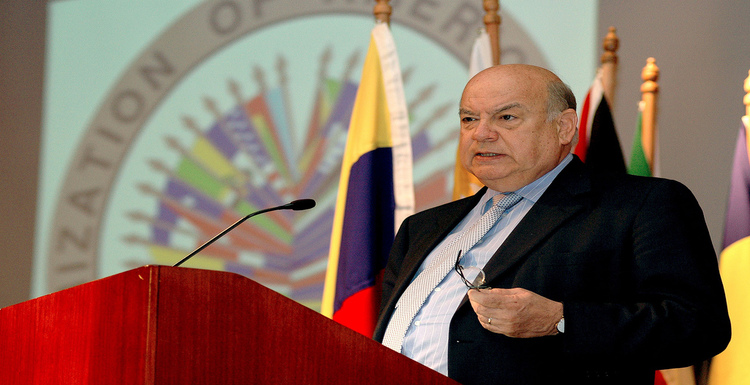Insulza’s legacy
By: Gonzalo Escribano, COHA Guest Scholar and Lecturer of Political Science and International Relations at the Iberoamericana University in Mexico City
In 2005, when José Miguel Insulza was elected Secretary General of the OAS for the first time, he presented himself as the candidate of a united Latin America. He faced the Mexican Foreign Minister Luis Ernesto Derbez, who presented a distinct North American alternative to Insulza’s agenda. A moderate Chilean socialist, Insulza’s legacy complied with the expectations at the time of his first election, but it would be challenged from both the left and the right.
Once in office, Insulza stood up to Washington on a number of occasions. During his term as Secretary General, the Free Trade Area of the Americas (FTAA) initiative, driven by US policymakers since the 1990’s with the intention of expanding the North American Free Trade Agreement (NAFTA) to the whole hemisphere, was officially left to die. Insulza took a significant stand against US interests after he facilitated the negotiations to revoke the 1962 resolution, promoted by the US, through which the Cuban government remained on the outside the organization.
But perhaps the most rebellious act on Insulza’s part as Secretary General, was to come up with the publication and promotion of the OAS Report on the Drug Problem in the Americas in which the organization openly suggested countries to try “alternative legal and regulatory regimes, starting with cannabis.” [1]
This was particularly significant in the region that had been most impacted by the prohibition regime and its internationalization led by the US. Since President Nixon declared the War on Drugs (WoD) in 1971, the US has consistently pushed this matter in its foreign policy agenda in the hemisphere. Even before the declaration of the WoD, the Federal Bureau of Narcotics was already establishing offices around the region. Along with the WoD, the DEA was established, and American agents were being sent to their embassies with the task of acquiring information to identify and convict drug-traffickers and to train foreign national police agents. Perhaps there is no better demonstration of the US hegemonic drive in the region than the unilateral process of Certification for Major Illicit Drug Producing and Transit Countries that would later be imposed on many countries. Although a paradigm shift leading to the liberalization of the drug economy would be sterile without the involvement of the US, the OAS position on drug legalization would represent the beginning of an anti-hegemonic coalition of Latin-American states against US drug-policies and foreign policy goals.
But many human rights activists and democrats in the region contest the legacy of Insulza. His realist position challenging the quality of US leadership within the OAS led him to treat Venezuela and Cuba too softly during crises that resulted in political persecutions and other abuses of civil and political rights. Insulza chose to transform the shape of the OAS while distancing the organization from Washington’s foreign policy intentions in the region, although this came at the price of renouncing its own liberal principles.
Uruguay’s former Foreign minister Luis Almagro was elected in March as successor of Insulza for the next five years. A respected member of the cabinet of former president José Mujica, Almagro is well known for his leftist positions although he is not particularly keen of the Venezuelan model. Under his leadership we can expect a continuation of what Insulza started. In 2013, Uruguay became the first country in the Americas to regulate the cannabis economy and Almagro has defended this drug-policy shift since then. His experience in the area of drug liberalization is likely to deepen the work on drugs and crime that the OAS started under Insulza. At the same time, Almagro’s leadership will maintain the new approach of the organization regarding Cuba, which will most likely participate in April’s Sixth Summit of the Americas in Panama and intensify the efforts of the OAS to promote hemispheric relations based on the themes of solidarity and social development.
By: Gonzalo Escribano, COHA Guest Scholar and Lecturer of Political Science and International Relations at the Iberoamericana University in Mexico City
Please accept this article as a free contribution from COHA, but if re-posting, please afford authorial and institutional attribution. Exclusive rights can be negotiated. For additional news and analysis on Latin America, please go to: LatinNews.com and Rights Action.
Featured Image By: Pontificia Universidad Católica de Chile, “La UC se convirtió en sede del XXVI Modelo de Asamblea General de la OEA para universidades,” Retrieved from WikiCommons, accessed April 2, 2015, http://commons.wikimedia. org/wiki/José_Miguel_Insulza#/media/File:La_UC_se_convirtió_en_sede_del_XXVI_Modelo_de_Asamblea_General_de_la_OEA_para_universidades.jpg.
[1] “Scenarios for the Drug Problem in the Americas: 2013-2025,” Organization of American States, in the report The Drug Problem in the Americas, under the mandate given to the OAS by the Head of Government of Member States Meeting at the 2012 Summit of the America in Cartagena de Indies (May 2013): 23.


